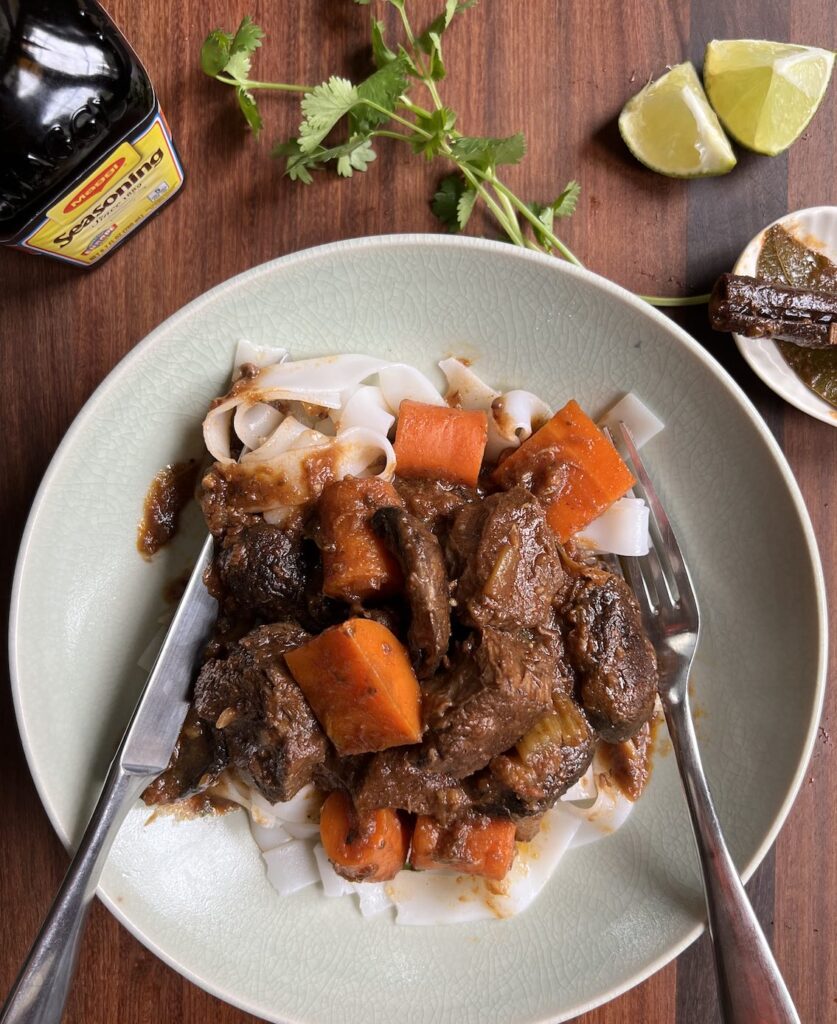
Ask me about iconic Viet dishes and within my list is bo kho, a beef stew of lemongrass, tomato, star anise, and lots of carrots. I have recipes for it in my first cookbook and Vietnamese Food Any Day. That stew takes cues from Chinese-style beef stew and some say, French beef and carrot stew. But it’s seasoned with nuoc mam and eaten with baguette or rice noodles. Most people say it’s Viet more than French or Chinese.
If you ask me about a French-style beef stew that Viet people prepare, I’d direct you to boeuf bourguinon, which my family prepared from Julia Child or Paul Bocuse recipes. We cooked straight up French versions because we could afford to in America – from affordable beef and inexpensive red wine sourced from Gallo or Trader Joe’s!
In Vietnam where beef is a luxe ingredient (pork or chicken bones are commonly mixed with beef bones for pho) and red wine is pricey, the go-to recipe is bò sốt vang – bò means beef, sốt means sauce, and vang is pigeon Vietnamese for vin, which means wine in French. Despite the “beef in wine sauce” name, most bò sốt vang recipes involve beef shank briefly marinated in a few tablespoons of red wine plus MSG or other spices. Red wine is a high value ingredient so it’s minimally used. Beef shank has a gelatinous chew and mild flavor that many Viet people prefer. In coming up with a wine-y take on bò sốt vang, I tweaked things but kept the foundational ingredients intact.
Getting the Vang to Reflect the Vin
There is wine produced in Dalat, Vietnam, but even so, it’s pricey for most folks and cooks use it sparingly. In my California home, I have a lot of wine and can afford to be more generous. I employ red wine for injecting flavor, and not just in the name. To that end, I soaked the beef in the wine overnight. The wine flavor penetrated the beef, which had been cut as cubes from a boneless beef chuck roast; beef shank does not have a beefy enough flavor to stand up to the red wine and it takes about 50 percent longer to reach a tender-firm finish. The wine's acidity didn’t really tenderize the meat. I still had to simmer the stew for about two hours total. But the wine flavor came through and what else do you want for your bò sốt vang but that vang flavor?!
As for what kind of wine to use, a big pinot was my choice here. You could choose a rich-tasting blend, if you like. You don't have to use the entire bottle so select a wine that you like to drink so you may have an extra good time while cooking.
Building a Vegetable-Driven Stew
Most beef stews have lots of meat and a moderately-low amount of vegetables. The veggies often perform as supporting cast members rather than co-stars. However, I find myself eating the stewed vegetables before finishing the beef, so for this recipe, I used less beef and lots of vegetables – celery, carrots and mushroom, to pump up umami, sweet-minerally flavor and health. By raw weight, there’s more veggies than beef.
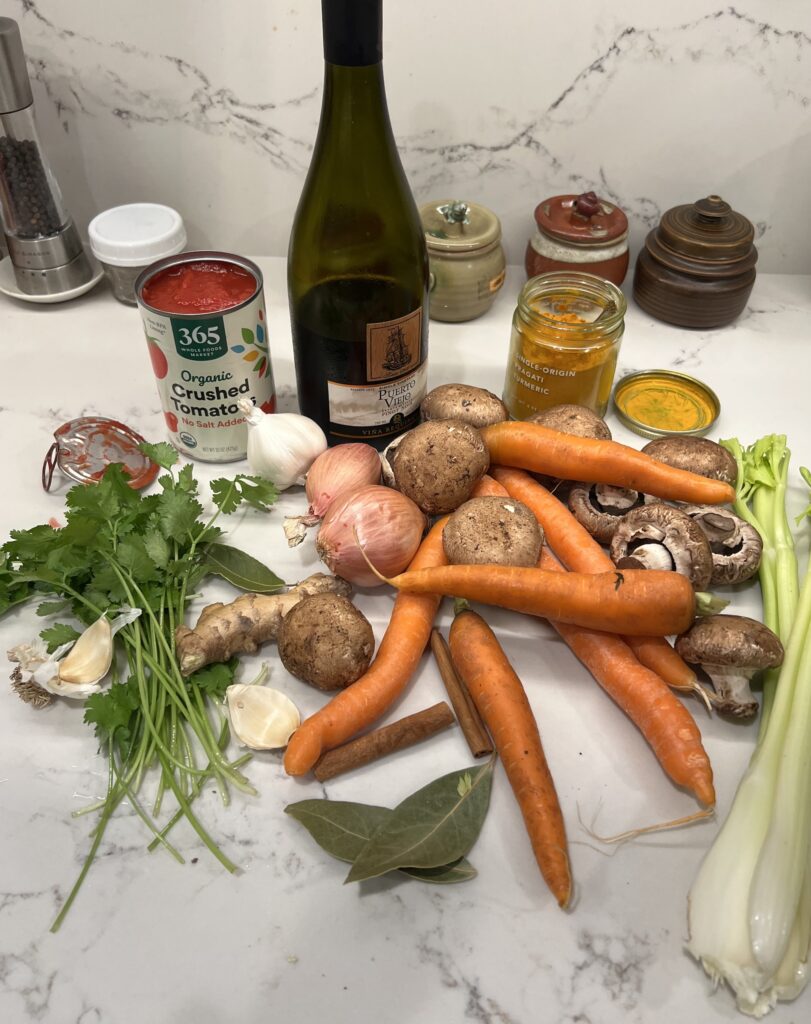
I went big with the cinnamon because my red wine was bold. I feared the stew being too tomato-ish with a whole can of crushed tomato in puree but it created a pleasantly thick sauce. For less tomato-ness, try whole canned tomato or diced tomato instead; the sauce texture will be looser.
Why Cook the Mushrooms Before Adding Them?
You're aiming to layer flavors here. Searing the mushrooms concentrates their earthy, meatiness. They are briefly cooked in the stew so although they meld somewhat with the stew, they still retain plenty of personality. I selected creminis that had opened their caps to reveal their gills. I find that they have more flavor than ones that have not. It's totally up to you.
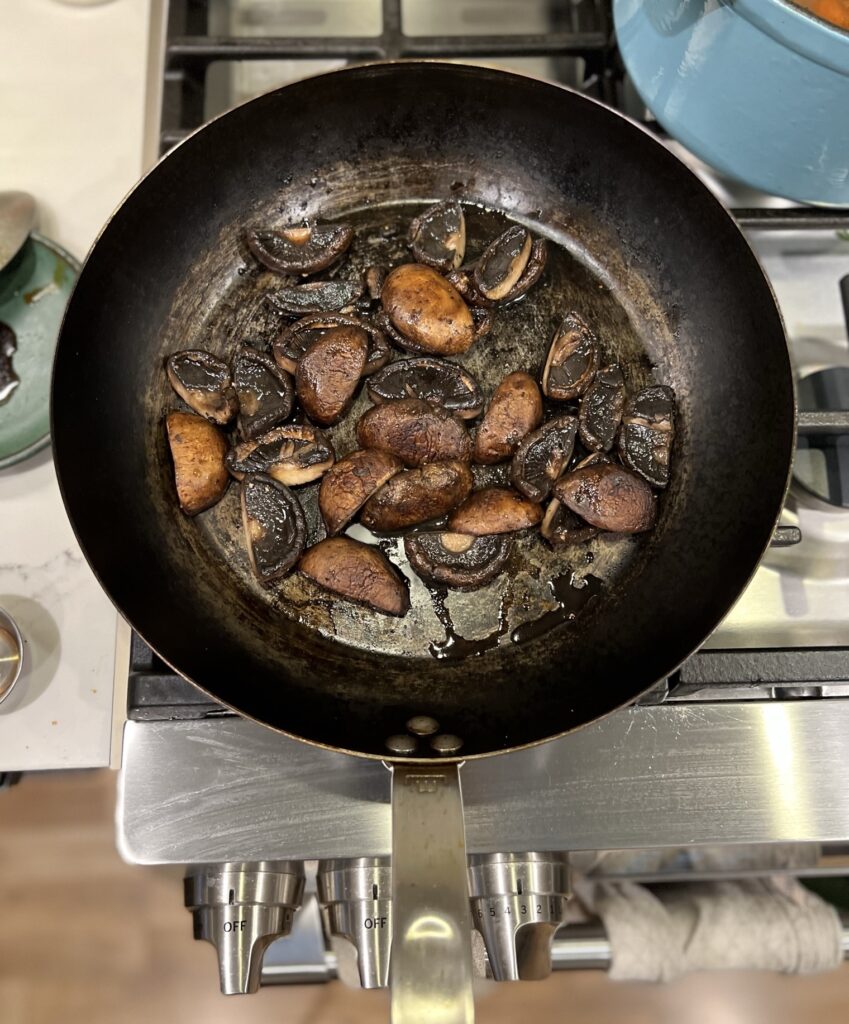
Beef in Red Wine Stew Video Recap
Here’s how it went down in my kitchen when I made the stew. I let the beef soak overnight. You can pause cooking after the initial 1 ¼-hour simmering, let things cool, and then refrigerate overnight. As usual, if you don't see the video, consider removing any ad blockers that may be in place. AND, if the video player asks you to stay or (The ad revenue goes to support my ability to continue this site.)
How to Serve the Stew?
The easiest path would be to dunk crusty bread into the stew. You could get fancy by serving the stew with a mound of mashed potatoes. Corn grits would be excellent, too. But for a Viet touch, I went with noodles -- wide rice noodles, like what you'd stir-fry as chow fun. I buy mine mostly as dried noodles.
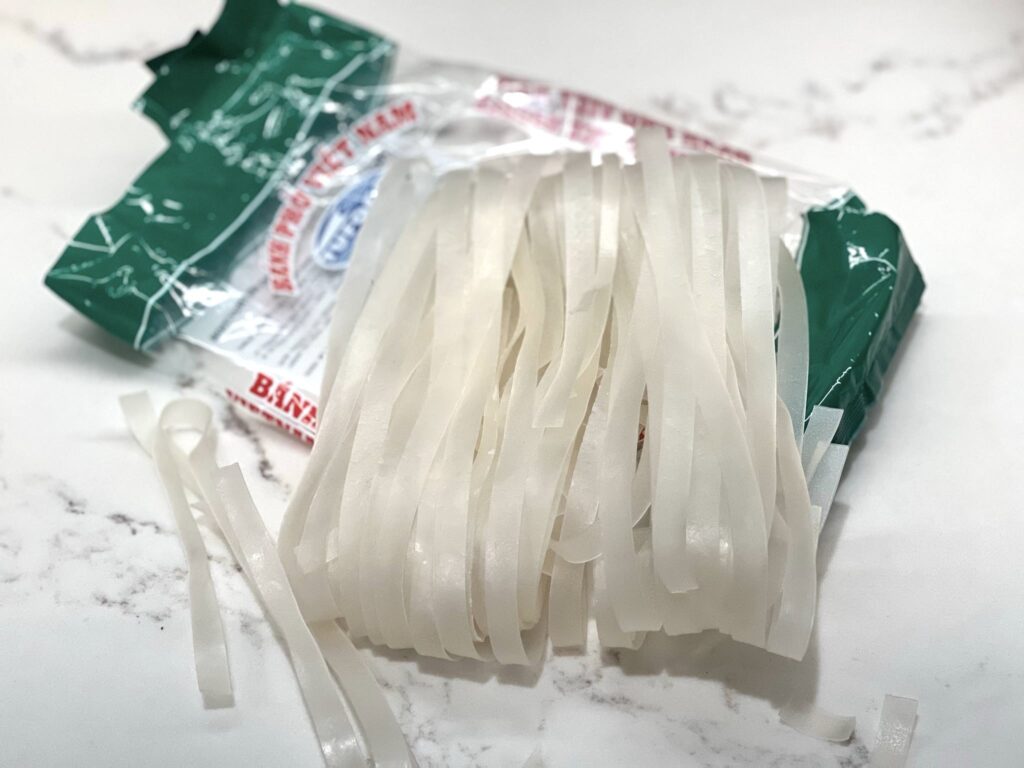
These rice noodles are as wide as pappardelle, which you could sub instead of rice noodles (banh pho). Do note that rice-based pappardelle is available nowadays in the gluten-free pasta section of many supermarkets. Before heading over there, check the market's Asian ingredient section for brands such as Taste of Thai. Depending on how you want to serve this stew, you could nudge bò sốt vang further east or west.
Bonus tidbits
If you don't know what Maggi is, check out my primer on the beloved condiment. Also, here's a Vietnamese condiment cheat sheet that may help.
Beef Stew in Red Wine Stew
Ingredients
- 1 ¾ pounds trimmed boneless beef chuck, cut into 1 ½-inch cubes
- Cloves from 1 small head of garlic, halved
- About 2 ½ cups red wine, plus more as needed
- 4 ½ tablespoons neutral oil (such as canola or peanut)
- Fine sea salt
- Recently ground black pepper
- Mounded ¼ teaspoon ground turmeric
- ¾ cup chopped shallot or yellow onion
- 1 ½ teaspoons packed minced ginger
- 14.5- oz can crushed tomatoes
- 2 large celery ribs cut into 1-inch pieces
- ½ cup coarsely chopped cilantro, plus more for garnish
- 2 large bay leaves
- 1 or 2 cinnamon sticks (see Note)
- 2 tablespoons Maggi Seasoning sauce or Bragg Liquid Aminos, plus more as needed
- 8 ounces large cremini mushrooms, trimmed of stems, caps halved
- 1 pound carrots, scrubbed and cut into bite-size pieces
- Granulated sugar, for seasoning
- 1 lime, cut as wedges, for serving
Instructions
- Put the beef and garlic into a medium bowl and 2 ½ cups red wine; add more if needed to cover the meat. Cover the bowl and refrigerate overnight or up to 24 hours. Using a mesh strainer, strain the beef, garlic and wine, saving the wine. Let the solids sit for 10 minutes. Transfer the beef to a baking sheet or plate and use paper towel or a clean dish cloth to pat excess moisture from the beef. Season the beef with ¾ teaspoon salt, ¼ teaspoon pepper, and the turmeric, coating well.
- Set a 5-quart Dutch oven over medium-high heat and add 3 tablespoons oil. When rippling, add half of the beef, let it sear and gently brown all over then transfer to a plate; repeat to brown the remaining beef, adding 1 tablespoon of oil as needed.
- Turn down the heat to medium and add the shallot. Cook for 2 to 3 minutes, until many pieces turn golden, then add the ginger and garlic (from the meat marinade). Cook for about 1 minute, until aromatic, then add the celery, and cook for a few minutes to develop flavor before adding the wine, tomato. Once gently bubbling, add the beef, cilantro, bay leaves, and cinnamon.
- Increase the heat to bring the pot to boil, then lower it to gently simmer. Cover and cook for 1 ¼ hours, until the beef is chewy-tender. Uncover and add the carrots. Continue gently simmering for 30 to 40 minutes, covered, until the carrots and beef are just tender. If the stew needs water, add a splash.
- Meanwhile, set a large skillet over medium-high heat. Swirl in the remaining 1 ½ tablespoons oil and when rippling, add the mushroom caps. Season with 2 or 3 pinches of salt and a light sprinkling of pepper. When glistening, add 1 ½ teaspoons Maggi and 2 tablespoons red wine. Swiftly stir and cook, until the mushrooms have just softened. Remove from the heat, and let rest.
- When the carrots and beef are tender enough, add the mushroom. Cook for another 5 to 10 minutes, to allow flavors to develop. Taste and season with 1 ½ tablespoons Maggi. You may add more Maggi for umami depth but it will darken the sauce. Use salt if you care about the color. To curb any tart edge, season with sugar by the ½ teaspoon. Add pepper for pungent heat.
- Let the stew rest, uncovered, for about 10 minutes before serving with a sprinkle of cilantro and lime wedges, if you like. Warn diners about the bay leaf and cinnamon sticks, if you have not removed them while dishing the stew up.













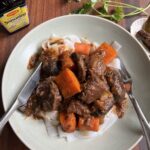
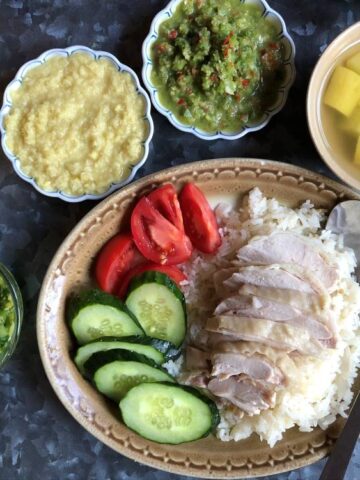
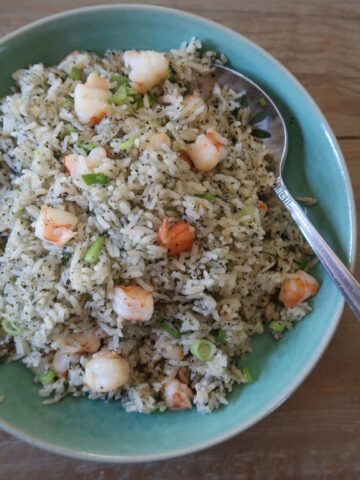


Brushjl says
Delicious! I wish I'd read the whole recipe in advance. I served with rice, but heart asian noodles would have been much better.
Andrea Nguyen says
No worries! I'm glad you enjoyed the stew! Try it with noodles the next time.
Lor says
I was wondering if you could explain what marinating the beef in wine before the cook does?
This an amazing recipe and excited to try your other recipes!
Andrea Nguyen says
Marinating the beef in wine helps to tenderize the meat (but don't leave it in there for too long) and it imparts a complexity of flavor. Hope you enjoy the recipe!